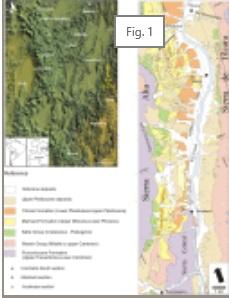Claudia I. Galli, Beatriz L. Coira, Ricardo N. Alonso, María P. Iglesia Llanos, Claudia B. Prezzi, Suzanne Mahlburg Kay
2 016
Journal of South American Earth Sciences,
This paper presents the tectonostratigraphic evolution of the Maimará Basin and explores the relationship between the clastic sediments and pyroclastic deposits in the basin and the evolution of the adjacent orogeny and magmatic arc. The sedimentary facies in this part of the basin include, in ascending order, an ephemeral fluvial system, a deep braided fluvial system and a medial to distal ephemeral fluvial system. We interpret that Maimará Formation accumulated in a basin that has developed two stages of accumulation. Stage 1 extended from 7 to 6.4 Ma and included accelerated tectonic uplift in the source areas, and it corresponds to the ephemeral fluvial system deposits. Stage 2, which extended from 6.4 to 4.8 Ma, corresponds to a tectonically quiescent period and included the development of the deep braided fluvial system deposits. The contact between the Maimará and Tilcara formations is always characterized by a regional unconformity and, in the study area, also shows pronounced erosion.
Rare earth element and other chemical characteristics of the tuff intervals in the Maimará Formation fall into two distinct groups suggesting the tuffs were erupted from two distinct late Miocene source regions. The first and most abundant group has characteristics that best match tuffs erupted from the Guacha, Pacana and Pastos Grandes calderas, which are located 200 and 230 km west of the study area at 22º-23º30′S latitude. The members the second group are chemically most similar to the Merihuaca Ignimbrite from the Cerro Galán caldera 290 km south-southwest of the studied section. The distinctive geochemical characteristics are excellent tools to reconstruct the stratigraphic evolution of the Neogene Maimará basin from 6.4 to 4.8 Ma.
Rare earth element and other chemical characteristics of the tuff intervals in the Maimará Formation fall into two distinct groups suggesting the tuffs were erupted from two distinct late Miocene source regions. The first and most abundant group has characteristics that best match tuffs erupted from the Guacha, Pacana and Pastos Grandes calderas, which are located 200 and 230 km west of the study area at 22º-23º30′S latitude. The members the second group are chemically most similar to the Merihuaca Ignimbrite from the Cerro Galán caldera 290 km south-southwest of the studied section. The distinctive geochemical characteristics are excellent tools to reconstruct the stratigraphic evolution of the Neogene Maimará basin from 6.4 to 4.8 Ma.
http://www.sciencedirect.com/science/article/pii/S0895981116301766

